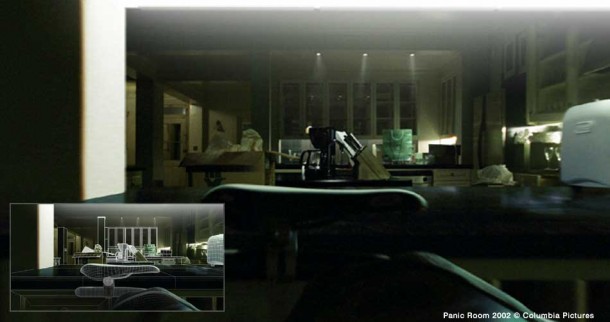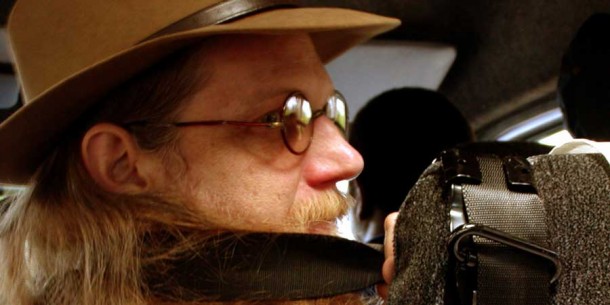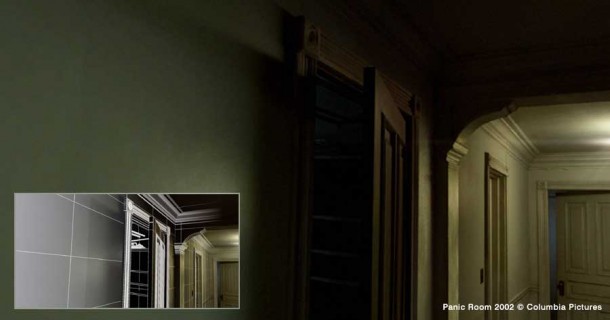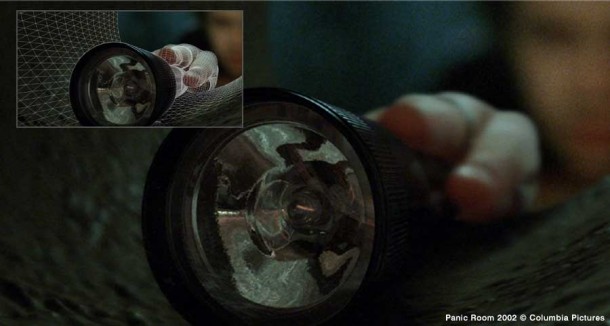An Interview with Kevin Tod Haug
IN THE FILM INDUSTRY, HE IS THE MAN TO CALL WHEN THINGS BECOME “MISSION IMPOSSIBLE”.
He began his career in the late 70’s as one of the first motion control programmers/operators in a field that was, and still is cutting-edge technology. In the mid 80’s, he got involved in some of the very first CG and video productions.
In the 90’s, Kevin had the chance to play with everything that had digital technology in it. He worked with producer Ceän Chaffin on two high profile music videos for Mark Romanek (Madonna’s “Bedtime Stories” and Michael and Janet Jackson’s “Scream” along with a string of high-end effects commercials.
In 1996, Ceän asked him to supervise the effects for Fincher’s “The Game” and in 1998 was asked to work on “Fight Club”. This later led to work on the visually stunning “The Cell” and the highly intricate “Panic Room”.
Introducing Kevin Tod Haug:
CGC: Could you begin by giving us a backgrounder of yourself?
KH: That’s a big question that I would like to refer to my website for a complete answer.
In brief: I am a freelance VFX Supervisor of what I like to think of as the “Mike Fink School”. In other words, I come from a Production background, not from a VFX production-house or “vendor”. I see myself as a Department Head, similar to the Production Designer or the DP: I work for the Director the vendors are my crew.
Another important aspect to my background is that when I started in this industry all effects were mechanically achieved. The first paradigm shift that I experienced was to “computer assisted” effects. Now, virtually any effect can be “computer generated” so the decision to do so is up to the particular circumstances of the effect required.
CGC: One of your latest and most prolific projects was the Panic Room, what role did you have in this film?
KH: I worked for fincher, as the Visual Effects Supervisor, supervising three CG vendors (BUF, Toy Box and Computer Cafe) and VFX Unit photography.
CGC: Some of the VFX shots in this film are so seamlessly integrated into the film; most people don’t even notice they are there. Could you tell us more about the marquee shot where the camera seamlessly “floats” through the house and blends live elements with CG?
KH: We simply called it “The Big Shot” it was a series of hook-ups between live action and CG environments. It was built from eight live plates and hundreds of large-format stills all taken on one of the Brownstone sets, from which BUF built the CG brownstone you see through out the shot. There is virtually no instant when you are seeing a frame that has not been generated in 3D.
CGC: Can you explain what you mean by Image-based modeling or “Photogrammetry” as you call it?
KH: I tend to use the term “photogrammetry” because that is the term BUF uses. Image-Based Modeling is a term Paul Debevic uses that is virtually synonymous.
In brief, it is the creation of 3D data from multiple 2D images. It has been used in one form or other since the 1st World War.
CGC: How is this done?
KH: It is essentially building the 3D mesh by comparing it to multiple images (views) of the object. The next step is projecting the images back onto the model as maps, thereby getting “photo-real” textures and lighting. The art to making this technique work is how you manage reflections and other perspective clues that need to be added or taken away.
CGC: Can you give an example from Panic Room?
KH: The best example is the Kitchen from “The Big Shot”. First Unit shot all of the live action moves because there were always actors in the shot.
In the case of the kitchen we gutted the set of all the counters etc that would have gotten in the way of the camera and replaced them with stanchions to which LED tracking points were attached.
The Live Plate was shot with a motion control boom that had to move very fast across the room, which caused a lot of vibration that was not necessarily repeatable.
We shot a number of passes with Forest approaching the doors without any glass in the window frames to avoid reflections of the camera rig. We did do one pass at the request of Olivier, the lead animator from BUF, that had no doors at all but in the end fincher didn’t like the performance in that take.
We then put the kitchen back together and they shot live action in it for a week, tweaking the lighting, establishing continuity etc. In the next hole in the schedule we went in, for a week, with a custom, large format, camera that shot with 65mm color negative of the same emulsion as the 35mm stock 1st unit was using, and shot hundreds of stills.
We documented every aspect of the kitchen that could be seen from the plate as well as everything that would reflect in the windows at the back of the kitchen, which was pretty much every thing.
We made prints of the stills and BUF picked the ones that they needed scanned, When fincher picked his live plates we scanned them. Then the fun started in Paris. They had to build the entire kitchen from the stills and the plates. They justified any discrepancies between views into one unified model of the kitchen. They stabilized the motion control plates and finally composited the whole thing together so we could get a look at it.
In fincher terms at this point we were “half-way-there”, in other words, we were now into delivery mode, which took about another nine months of tweaking.
CGC: You seem to be able to do just about anything with camera, even the “impossible” ones.
KH: The “impossible” camera thing is something that we took to a new level in Panic Room. We used it for all types of shots and frequently, I think, only the cognoscenti can tell that they are not entirely practical shots. What I think is interesting about using photogrammetry, as a camera technique is that it really does fit into the tools a DP can consider to get a shot. In the end it is just a very specialized way of moving the camera within the environment that the DP has lit. I believe that there is no legitimate reason these shots could not be used on a DP’s reel.
CGC: Are there things in the past you have indeed considered impossible?
KH: Sure, that’s why I have a job. If it were possible to do the things I’m responsible for, other department heads would take care of them. The VFX Dept. is essentially the Impossibility Dept.
CGC: What was the most difficult aspect of rendering a 3D environment that would blend-in perfectly into the real world?
KH: Lighting; texture and lighting. Environments are relatively easy to manage so long as they are something the majority of the audience is familiar with. Animation is usually the hardest thing to get right but with environments animation is minimal and usually comes from the camera move so it is within our control.
This brings the up the fact that THE hardest thing to do is to convince an audience that something that is impossible is actually happening. It is so much easier to convince people that they are looking at something they are familiar with than something they have never seen before. This is basic to human perception; our brains look for consistencies, things that we don’t have to work at understanding, and just fill in the blanks from memory. This is why matte paintings have always worked so well. If our brains are given the right clues then we are content to accept what we are being asked to believe and get on with processing new information.
This all breaks down when you ask an audience to believe something that they have no experience of. If you think of the worst effects that you can remember they are always something that just refused to fit into world that the story took place in.
So… I believe that the greatest challenge is to make something impossible seem as explicable, as normal, as possible so an audience can accept it an get on with the story rather than scrutinize it until it becomes clear that it is “fake” and does not belong in the movie.

CGC: As a filmmaker, how did the new digital production techniques change the way you work over the past few years?
KH: It shortened my hours for a while, no need to be there all hours of the day and night until the shot was “in-the-can”. But now, I can work with artists on different continents/time-zones so the work never really ends. So in the end I still need the stamina to match the compulsiveness that this work requires.
CGC: From your perspective, what do you believe will be the next big thing?
KH: Integration: The Paradigm has shifted from animation that is distinct from photography to animation that is indistinguishable from photography. All that is left is for a new generation of filmmakers to completely integrate the two into “the Way movies are made” with no consideration for whether a film is an “effects film” or not. When and how that happens will determine not only the role of visual effects in movie making but also the nature of cinema.
CGC: When will we have the chance to see your next “Impossible Shot”?
KH: Impossible to say.
Many thanks to Carole Bouchard (CG Channel) and Patricia Boulogne (BUF) for making this story possible.
Related Links:



